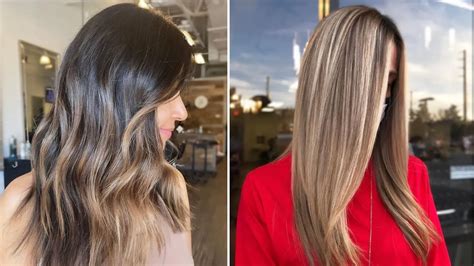Introduction

When it comes to enhancing your hair’s allure, balayage and highlights emerge as two popular techniques that add depth, dimension, and a touch of vibrancy. While they share the goal of brightening your locks, these techniques boast distinct characteristics that impact the overall look and feel of your hair.
What is Balayage?
Balayage, a French term meaning “to sweep,” is a freehand painting technique that creates natural-looking, sun-kissed highlights. The colorist uses a brush to apply lightener to the hair’s surface, typically starting from the mid-lengths and gradually blending into the roots. This method results in a soft, diffused effect that mimics the natural lightening caused by sunlight.
What are Highlights?
Highlights involve isolating small sections of hair and applying lightener to them to achieve brighter, bolder streaks. The hair is typically divided into foils or caps, with the lightener applied to specific strands. This technique creates a more defined, contrasted look, giving the hair a multidimensional appearance.
1. Application Technique:
- Balayage: Freehand painting with a brush, blending lightener into the hair’s surface
- Highlights: Isolating hair sections and applying lightener directly to specific strands
2. Effect:
- Balayage: Soft, diffused highlights with a natural, sun-kissed appearance
- Highlights: Bolder, more defined streaks that add contrast and dimension
3. Maintenance:
- Balayage: Typically requires less maintenance as the highlights blend seamlessly into the base color
- Highlights: May require more frequent touch-ups due to the defined contrast
4. Damage:
- Balayage: Generally less damaging as the lightener is not applied directly to the roots
- Highlights: May cause more damage as the lightener is applied closer to the scalp
5. Cost:
- Balayage: Usually more expensive due to the time-consuming freehand application
- Highlights: Generally more affordable than balayage
The decision between balayage and highlights depends on your personal preferences and hair goals:
Consider Balayage if you prefer:
- A natural, sun-kissed look
- Minimal maintenance
- Less risk of damage
Consider Highlights if you prefer:
- Defined, bolder streaks
- High contrast and dimension
- A more dramatic result
| Feature | Balayage | Highlights |
|---|---|---|
| Application Technique | Freehand painting | Isolating hair sections |
| Effect | Soft, diffused highlights | Defined, brighter streaks |
| Maintenance | Less maintenance | More frequent touch-ups |
| Damage | Less damaging | More damaging |
| Cost | More expensive | More affordable |
Pain Points:
- Balayage can be time-consuming and expensive.
- Highlights can cause hair damage and require frequent touch-ups.
Motivations:
- Balayage provides a natural, effortless look.
- Highlights add depth and dimension to the hair.
- Consult with an experienced hairstylist to determine the best technique for your hair type and desired look.
- Use high-quality hair products to protect and maintain your highlighted or balayaged hair.
- Consider using deep conditioning treatments to repair any damage caused by hair lightening.
Balayage:
- Divide the hair into sections.
- Apply lightener in a freehand motion, starting from the mid-lengths.
- Blend the lightener into the roots to create a seamless transition.
Highlights:
- Isolate small sections of hair.
- Wrap the hair in foils or caps.
- Apply lightener directly to the exposed hair.
- Process the lightener according to the manufacturer’s instructions.
Balayage and highlights offer distinct approaches to enhancing your hair’s beauty. Balayage creates a natural, sun-kissed effect, while highlights add bolder, more defined streaks. Understanding the differences between these techniques will equip you to make an informed decision that aligns with your hair goals and personal style.
